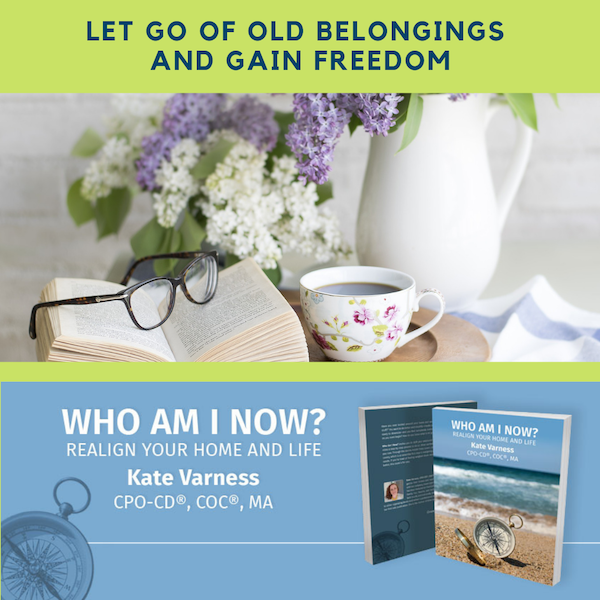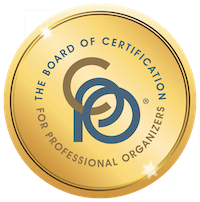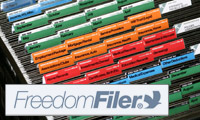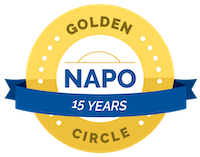Heading to the NAPO conference!

For the 13th time, I’m getting packed for the annual conference of the National Association of Productivity and Organizing Professionals. I’ve attended every year except 2014 when there was a conflict with my nephew’s bar mitzvah. (Family first, right?)
Attending is not inexpensive. But from the very beginning, I’ve invested in the conference because of the huge dividends is pays. Here are a few of the reasons I go:
- I learn so much about organizing and about running my business from the educational sessions and from talking with colleagues
- I’ve made professional associations that have helped my business
- I get to see friends year after year (it’s like summer camp!)
- I get to make new friends and associations
- I get to room with my dear friend Geralin Thomas whom I met at my second NAPO conference in 2007. We’ve been rooming together for years and it’s always a treat.
- I get to hang out with my local chapter members in a new environment (there are more than a dozen of us going this year!)
- Attending conference makes me a better professional organizer
When you work for yourself, time away from home to attend a conference also affects your income. But, for me, attending the NAPO Conference is worth the investment (and the absence of income).
If you’re an organizer and haven’t attended, I encourage you to make plans to attend the 2020 conference. The location hasn’t yet been announced, but it’s sure to be good!
Letting laundry help me get things done

Back in 2010, I wrote a post called Laundry as a time-management tool. I thought of that post yesterday morning, when I realized I needed to fit laundry into my work-at-my-desk day. I ordinarily do laundry on the weekend but I was out of town this past weekend—and I didn’t have enough pairs of underwear to tide me over.
I decided to put the principles of that post to work. And of course I decided to blog about it.
Just as I did nine years ago, I realized I could use the laundry as a tool to help me stay focused. The time-management guru, Mark Forster talks about the concept of “timed bursts” in his excellent book, Do It Tomorrow and Other Secrets of Time Management. With timed bursts, I use a timer and focus on my work until the timer goes off. At that very instant, I stop what I’m doing and take a break. By interrupting myself mid-task I make it easier to get back to work, because the brain craves completion.
Yesterday’s laundry breaks also gave me a chance to refocus on what I was supposed to be doing. Since I was away for the last five days, I had a task list as long as my arm. Unfortunately, I find that it’s really easy to get sidetracked by tasks that occur to me but aren’t on the list. Physically getting up to deal with the laundry allowed me to focus on my list again when I sat back down.
Mark says that taking these breaks allows you to get more done. “If you work on something for three bursts of 20 minutes,” he writes in Do It Tomorrow, “you are likely to get more done than if you do an hour’s untimed work on it.”
So I decided to make the intervals where the laundry was washing and drying my timed burst. I set a timer and when it went off, I immediately got up from my desk, transferred the wet laundry and folded and put away the dry clothes. That was about a five- to ten-minute break. Once the clothes were dealt with, I headed right back to work.
It worked very nicely, and the result—clean laundry + items checked off my list—was truly rewarding!
New book to check out: Who Am I Now?
My friend, Kate Varness of Green Light Organizing and Coaching a Certified Professional Organizer in Chronic Disorganization® as well as a Certified Organizer Coach®, is launching her new book, Who Am I Now? Realign Your Home and Life today!
Kate and I served together on the Board of Directors of the Institute for Challenging Disorganization from 2010 to 2012 and I know what a smart, caring and insightful professional organizer she is, so I jumped at the chance to help her launch her book.
Kate has written the book for people who have experienced a life transition and are living with the clutter that resulted from stuff getting tucked away while other priorities took over (something that professional organizers see with a certain amount of frequency). Kate has come to understand that often people don’t address this clutter because addressing it would mean recognizing that life has shifted and it would require taking some action to move on from the past. And that can be hard.

This book is designed to help people rediscover who they are now, using compelling stories, no-nonsense strategies, and exploratory questions. Kate teaches readers:
- How to navigate the change process
- Why it is so important to examine who you are now
- What underlying beliefs interfere with the decluttering process
- Strategies for letting go and getting started
- How successfully get through the clutter backlog and create new habits
Doesn’t that sound great? Once you’ve made all these self discoveries, you can realign your life and belongings, and make space in your home for joyful living. If this resonates with you, I encourage you to pick up this book.
Kate’s writing and coaching skills shine through in the book, as does her vast experience helping people as a professional organizer. It’s not only an enjoyable read, it’s full of wisdom and practical advice.
I hope this book becomes a bestseller, not just because I like Kate a lot and wish her success, but because this book has the ability to really touch people’s lives.
Worth repeating: Dealing with orphan socks
Nearly five years ago, I posted about my clever clients system for handling socks that have lost their mates. I still love the simplicity and visibility of this system!

As I toured a new client’s home recently, I was struck by the clever solution she had created in her laundry room for dealing with orphan socks. She created a sock wall!
When a sock comes out of the dryer that doesn’t have a mate, she just pins it to the wall using a push pin. If the missing sock shows up in a subsequent load, she can easily identify its mate. She told me that if an orphan sock languishes for a period of time, she tosses it.
I think this is great, because it’s easy, sustainable, and very visible. I think if it were my laundry room, I might want to minimize holes in the wall (and socks) by putting up a bulletin board of some sort and using push pins with binder clips to hold the socks. But the principle is terrific!
Orphan socks aren’t a huge problem in my home because we minimize the number of different types of socks we have. My husband and I each have one type of white socks we wear with sneakers and a minimal number of dark socks. When I do come up with a sock without a mate, I just put it in the sock drawer and trust its mate will join it soon.
What about you? How do you handle orphan socks?
Why hire a Certified Professional Organizer?

Back in 2008, three years after I started my business, I earned the credential Certified Professional Organizer® or CPO®. This credential is conferred by the Board of Certification for Professional Organizers as part of an accredited credentialing program. In order to become a CPO, I had to pass an exam that I studied hard for. In order to sit for the exam, I had to have 1500 paid client hours or 1250 paid client hours and 250 equivalent educational hours. (I had the latter.)
To maintain my certification, I must have 15 Continuing Education Units (i.e. hours of education) every year; I have recertified every three years, in 2011, 2014 and 2017. It’s clear that there is some time and expense involved in being a CPO. So why do I do it? Many successful organizers aren’t certified—in fact, I’m one of only three CPOs in the St. Louis area and only five statewide. (See the CPO Directory.)
I do it for two simple reasons: (1) I’m very proud of the credential and (2) I think it demonstrates to my clients and prospective clients that I hold myself to a very high standard. I am bound by an enforceable code of ethics and that I am committed to experience, education and ethics.
When you invite an organizer into your home, you expose your challenges to us and it can feel a bit vulnerable. Finding the right organizer for you can take a little research, but you can narrow down the field by looking for a CPO or for a member of the National Association of Productivity and Organizing Professionals (NAPO). (If you’re in St. Louis, check out the website of NAPO’s St. Louis chapter for a listing of all our great members.) Another great place to look for a trained organizer is the Institute for Challenging Disorganization (ICD). ICD subscribers are also consummate professionals, with a special interest in chronic disorganization.
There are a lot of choices out there. I hope this helps you narrow it down!
Spring 2019 edition of Secrets of Getting Organized Magazine
Just a couple of months ago, I wrote a post about being included in the Early Spring 2019 edition of Secrets of Getting Organized Magazine. Well, there’s a new edition of the magazine out, the Spring 2019 edition and I’m quoted again!
This issue has completely different content than the early spring edition. I’m quoted in articles on organizing pet gear (p. 39) and also paper catchalls (p. 89). To be honest, my contribution this time around is fairly minimal. But the contributions of my organizing colleagues (our pictures and bios are in the back) really make the issue one worth buying, in my opinion.
Here’s the cover, so you can pick it out on the newsstand.

There are lots of great articles. But I particularly enjoyed these:
- Field notes: Always in Style, about an office and studio for a Seattle-based textile business
- Stop the Clutter at the Door, with some great storage ideas for mudrooms
- Unpackaging 101, about what items to decant in your pantry (and how to do it)
- Clear the Counter, about bathroom organizing
There are many other beautiful articles that I found very interesting. The issue went on sale on March 8 and will be available through June 7. You can buy it (the cover price is $9.99) at newsstands and bookstores nationwide and as well as grocery stores, big box retailers and home centers. I’m honored to be associated with it!
Worth repeating: Decluttering old papers and memories
I wrote this post in October 2015 and reading it today made me appreciate the big task I accomplished in getting rid of all those papers and memories. Here’s the good news: In the three and a half years since I let that stuff ago, I haven’t missed one thing. Not one. Letting go is definitely liberating!

Over the weekend, I faced down the challenging of decluttering a file cabinet full of old papers and memories. I love having these experiences that put me in my clients’ shoes and help me better understand what they’re going through.
A number of years ago, I moved my office four-drawer filing cabinet into the basement, replacing it in my office with an Elfa file cart. I didn’t bother decluttering the stuff that moved to the basement with the file cabinet. It was all papers related to achievements in my first two (and only) jobs, as well as administrative and project files from my decade as a dog writer, along with over 100 files of newspaper and magazine clippings of published articles I’d written.
They might have sat there until we moved, except that we’re doing a big repair and renovation in our basement, so the file cabinet has to be moved several times. It seems like a good time to (literally) lighten the load in that cabinet.
So I went to the basement and started going through the files. It was a fun and sometimes sad trip down memory lane. The tricky part was much of the material in that file cabinet pre-dated the worldwide web as we know it so isn’t available online (or at least not easily). I always caution people to give some thoughtful consideration to discarding irreplaceable items, but I also tell them that the more sentimental items they keep, the less value any of it has. So I was experiencing the push-me-pull-you of those two factors.
In the eighties, I worked for a non-profit on an international project that involved publishing magazine supplements in magazines around the world. I had a copy of each of those supplements. They really don’t have any value for me—in thirty years I’ve never once been asked about them. Yet they evoke some fond memories. (I traveled around the world and met those magazine editors.) And I don’t think they exist in digital form. What to do?
After a little thought, I decided to keep one of them and recycle the rest. That felt a little scary but also gave me that great feeling of lightening the load.
My next job was doing media relations for the Missouri Botanical Garden and I had kept some important clippings I’d placed. Back then I was able to garner some pretty significant attention for stories that felt like a very hard sell. Those clippings and the news releases I’d written to place them could be handy if I were every seeking a job in media relations. But the likelihood of that is close to nil. So I ended up keeping a little portfolio I’d created back then and recycling everything else.
Then I came to the more recent career—all the files from when I was a dog writer from 1995 to 2005, when I started Peace of Mind Organizing. I threw away all past project files, which was a pretty easy decision. Then I dealt with the clipping files. I wrote something like 150 articles and back in those pre-internet days one mailed photocopies of clippings with query letters to try to get magazine assignments. So I had made a bunch of copies of every article I published. Only laziness had stopped me from getting rid of the extras years ago. Yesterday, in the spirit of lightening the load, I kept one copy only of the more significant articles, like the ones that appeared in national magazines (I wrote quite a bit for Family Circle—that’s part of one of my favorite Family Circle articles in the photo above), the columns I wrote for a now-defunct magazine and a now-defunct website, and the articles for which I won awards. I went from hundreds of files to a single, fairly thick, file.
Going through this process was a great mental exercise. I got to revisit some achievements, which is always fun. I cried when I read the column I’d written after our dog, Scout, died in October 2001 and the one I wrote after our other dog, Kramer, died in December 2001. It made me appreciate, as I probably didn’t at the time, that those articles probably helped others who were grieving the loss of their pets. I’m glad I kept hard copies of those because they’d be tricky to find online.
Do you have ancient files or other memorabilia lurking somewhere in your house? I encourage you to bring them out into the light and go through them. You may jog some really fond memories. And you find it easier than you think to let go of this particular type of excess. Trust me, it can be liberating!
Links
- Organize Your Family History
- Peace of Mind Spending
- Shannon Wilkinson, life coach
- National Association of Productivity and Organizing Professionals
- Institute for Challenging Disorganization
- Are you interested in becoming a professional organizer?
- Ravelry
- NAPO St. Louis
- Getting to Good Enough podcast







